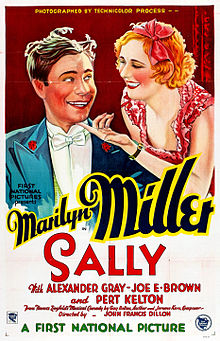Sally (1929 film)
| Sally | |
|---|---|
 theatrical release poster | |
| Directed by | John Francis Dillon |
| Written by | Waldemar Young A.P. Younger |
| Based on | Sally by Guy Bolton and P.G. Wodehouse |
| Starring | Marilyn Miller Alexander Gray Joe E. Brown Pert Kelton |
| Cinematography | Dev Jennings Charles Edgar Schoenbaum (Technicolor) |
| Edited by | LeRoy Stone |
| Music by | Jerome Kern Leonid S. Leonardi Irving Berlin Al Dubin Joe Burke |
| Color process | Technicolor Two-Strip (original) |
Production company | |
| Distributed by | Warner Bros. Pictures |
Release date |
|
Running time | 103 minutes |
| Country | United States |
| Language | English |
| Budget | $647,000[1] |
| Box office | $2,198,000[1] |
Sally is a 1929 Hollywood film. It is the fourth all-sound, all-color feature film made, and it was photographed in the Technicolor process. It was the sixth feature film to contain color that had been released by Warner Bros., the first five were The Desert Song (1929), On with the Show! (1929), Gold Diggers of Broadway (1929), Paris (1929), and The Show of Shows (1929). (Song of the West was completed by June 1929, but had its release delayed until March 1930). Although exhibited in a few select theaters in December 1929, Sally went into general release on January 12, 1930.
It was based on the Broadway stage hit Sally, produced by Florenz Ziegfeld (which played at The New Amsterdam Theatre, from December 21, 1920 to April 22, 1922), and retains three of the stage production's Jerome Kern songs ("Look for the Silver Lining", "Sally", and "Wild Rose"); the rest of the music newly written for the film by Al Dubin and Joe Burke.[2]
Marilyn Miller, who had played the leading part in the Broadway production, was hired by the Warner Brothers at an extravagant sum (reportedly $1,000 per hour for a total of $100,000) to star in the filmed version.[3] The film was nominated for an Academy Award for Best Art Direction by Jack Okey in 1930.[4][5]
Plot[]
Sally (Marilyn Miller) plays the part of an orphan who had been abandoned as a baby at the Bowling Green telephone exchange. While growing up in an orphanage, she discovered the joy of dancing. In an attempt to save money enough to become a dancer, Sally began working at odd jobs. While working as a waitress at a Childs Restaurant,[6] a man named Blair (Alexander Gray) begins coming to her work regularly to see her. They both soon fall for each other.
Sally, however, does not know that Blair has been forced into an engagement by his family with a socialite named Marcia (Nora Lane). One day, a theatrical agent shows up at Sally's work (T. Roy Barnes) and gives her a chance to audition for a job. Sally, however, ends up losing her job and the opportunity when she drops a tray of food into Barnes' lap. Eventually, Sally gets another job at the Elm Tree Inn, managed by Ford Sterling. Blair drops in one day and immediately takes an interest in Sally. He convinces Sterling to have Sally dance for his customers. While she is performing one day, the theatrical agent (T. Roy Barnes) notices her and convinces Sally to impersonate a famous Russian dancer named Noskerova at a party being given by Mrs. Ten Brock. At that engagement, she is found to be an imposter and is asked to leave. Before Sally leaves, however, she hears the announcement of Blair's engagement to Marcia. Undaunted, she proceeds with her life and eventually becomes a star on Broadway.
Cast[]
- Marilyn Miller as Sally/Noskerova
- Alexander Gray as Blair Farrell
- Joe E. Brown as Grand Duke Constantine
- T. Roy Barnes as Otis Hemingway Hooper
- Pert Kelton as Rosie, Otis' girlfriend
- Ford Sterling as 'Pops' Shendorff
- Maude Turner Gordon as Mrs. Ten Brock
- E. J. Ratcliffe as John Farquar
- Jack Duffy as The Old Roue
- Nora Lane as Marcia
Box office[]
According to Warner Bros. records, the film earned $1,219,000 domestically and $979,000 foreign.[1]
Preservation[]
Although never technically a lost film, Sally was unavailable for public viewing for nearly six decades. Warner Bros. sold rights to its pre-1950 film library to Associated Artists Productions.[7] It was not until around 1990 that the film became available for archival and revival screenings. However, the film survives only in black and white except for a 21⁄2-minute color segment from the "Wild Rose" musical number, discovered in the 1990s and inserted into the print currently in circulation. Sepia-toned black-and-white footage is inserted to replace individual frames missing in the color fragment.
See also[]
References[]
- ^ a b c Warner Bros financial information in The William Shaefer Ledger. See Appendix 1, Historical Journal of Film, Radio and Television, (1995) 15:sup1, 1-31 p 10 DOI: 10.1080/01439689508604551
- ^ Bradley, Edwin M. (1996). The First Hollywood Musicals: A Critical Filmography of 171 Features, 1927 Through 1932. McFarland & Company. pp. 87–90.
- ^ Photoplay, September 1929
- ^ "NY Times: Sally". Movies & TV Dept. The New York Times. Baseline & All Movie Guide. 2012. Archived from the original on October 17, 2012. Retrieved December 7, 2008.
- ^ Sally at silentera.com
- ^ The Brooklyn Citizen (Brooklyn, New York) · March 15, 1930, Sat · Page 2
- ^ 1957 MOVIES FROM AAP Warner Bros Features & Cartoons SALES BOOK DIRECTED AT TV
External links[]
- Sally at IMDb
- Sally synopsis, allmovie.com
- 1929 films
- English-language films
- 1920s color films
- Warner Bros. films
- American films
- Films directed by John Francis Dillon
- First National Pictures films
- Films based on musicals
- Films based on works by P. G. Wodehouse
- American black-and-white films